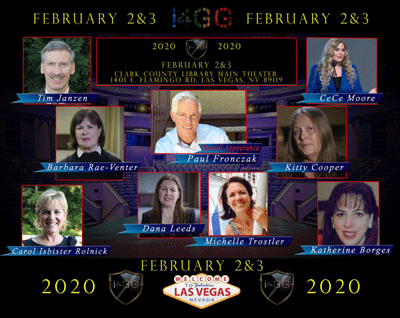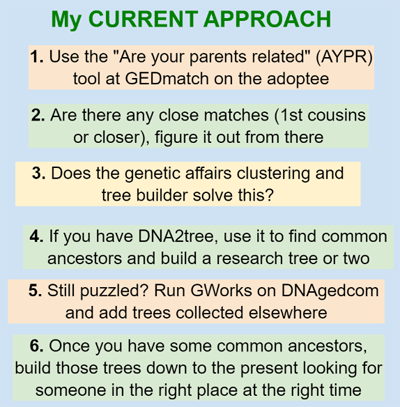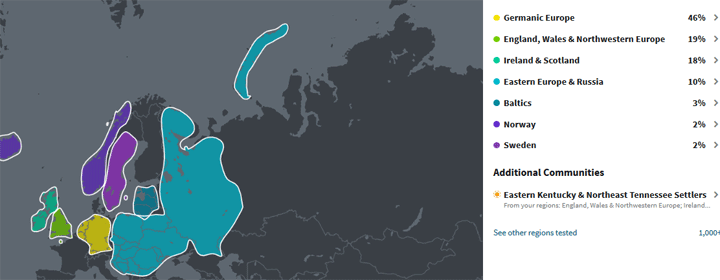Unknown parentage searches have changed dramatically over the last year thanks to a number of great new automated tools. I  will be updating my presentation on this for the upcoming i4GG conference in Las Vegas in a few weeks, the first weekend in February. I will also probably talk about what’s new at GEDmatch as well as be on a panel there.
will be updating my presentation on this for the upcoming i4GG conference in Las Vegas in a few weeks, the first weekend in February. I will also probably talk about what’s new at GEDmatch as well as be on a panel there.
Plus I will present how to use these new wonderful tools to explore your cousin matches at the North County DIG meeting next Saturday, January 18.
Below is a screen shot of the final slide in my unknown parentage presentation where I list the steps, in order, that I currently go through on these searches. I need to add at the beginning another step, “check the ethnicity,” as it can be a huge clue when the two parents are descended from very different populations. Click here for a recent blog post on a case solved with ethnicity. Also I have found that the listed communities at Ancestry are pretty accurate so they can be quite useful too.

Finding an unknown father in a few hours with DNA has become much more common due to the large number of American testers. A neighbor, let’s call her Dede, noticed I was a genealogist on FaceBook, so contacted me for help late one evening in December. She asked if I could help figure out who her unknown Dad was from her DNA results. She was a bit discouraged because no one had answered her messages.
Dede was tested on Ancestry and although her mother was not tested, a known maternal first cousin happened to be in her match list. That would be useful for separating the maternal from the paternal matches. Dede’s ethnicity had a surprisingly high 47% German percentage while her first cousin had only 27% . Plus that cousin had no Eastern Europe (Dede 10%) or Baltic (Dede 3%) so perhaps Dede’s father was part Germanic and Slavic.

Dede’s ethnicity at Ancestry – note the Kentucky community
I took a quick look at her Ancestry match list and saw several paternal 2nd and 3rd cousin matches so I told her that it would be pretty easy, then quoted her my discount rates and a estimate. The next day I sent her the wedding picture of her father’s parents. She and her family drove to Oregon after Christmas to get to know her half sister and Dad. What a magical Holiday it was for all!
The main tools I used for her case were DNA2tree, and Genetic Affairs clustering with tree building. With six paternal second cousin matches it would usually be quick, but four of them had no trees. At least those four looked to have real names but they had no surnames in common. One match had a sizable tree and although the other second cousin had only a three person tree, his mother had a Slavic surname that was also in the large tree. Time to use some automated tools to search the 3rd and 4th cousin trees as well.

The Kentucky family found by Genetic affairs – DeDe’s great great grandparents are on the far left, she is from another daughter, so the larger matches are 2C1R, and the others are 3rd cousins.
Clustering from Genetic Affairs with tree building found a family with deep Kentucky roots, shown above, that matched the listed community at Ancestry. DNA2tree found a coal mining family in Pennsylvania with origins in Yugoslavia that included the surname of interest. Actually they both found both families but DNA2tree built me the Yugoslavian family tree. As always, I had to build the trees of the children whose descendants were not tested, eight of them. Tree building is the expected grunt work of these searches.
Copying other trees comes in handy when you want to make a quick and dirty research tree to take advantage of the Ancestry DNA hinting system. Sometimes, as in this case, you find someone who is not a close DNA match who has a large and extensive tree that you can copy. There is even automation to help with that process, click here for that blog post.

The wedding picture I sent Dede of her paternal grandparents, used with “Ron’s” permission (from his tree)
By using those ancestor green leaf hints on this test tree, I found a tree that had both the Kentucky family and the Yugoslavs! Another technique that can speed up these searches is when you find a large tree for one side, search it for the surname from the other side. A marriage between those two families would have to be Dede’s grandparents unless there was more than one such marriage (brothers marrying sisters and the like). There was just one such union with just one son. Further sleuthing at newspapers.com found that the son had even been stationed in San Diego, where Dede was born, at the time of conception.
Now I sent Dede her grandparents wedding picture and told her to contact the owner of that tree, let’s call him Ron. An important step in this search was to click on the name of owner of that great tree in order to go to his profile. I saw that he had written a friendly introduction and he had last logged in “today.” Active researchers are likely to see and respond to messages.
Ron was helpful and nice and had even solved a few adoption cases with DNA himself. Once he heard how we came to our conclusions, he offered to send Dede’s contact information to her probable half sister, his cousin, with whom he was in touch. The happily ever after progressed from there.
I love it when it all comes together and everyone is happy! It does not always happen that way. Many fathers claim to never have known that woman … see my post called Not Always a Happy Ending; but more often in my experience, the new father is thrilled and had never even known about the pregnancy.
Dede’s bio Dad and family welcomed her with open arms; they are thrilled to now have grandchildren and great grandchildren (their daughter has no children). They are teaching Dede all about Yugoslavian culture. In an interesting twist, Dede’s husband is also of Yugoslavian descent. Dede said of her sister, “She and I are like two peas in a pod, same body shape, teeth, and so many little things in common.”
Wow!
Amazing! Thank you so much for sharing this! Since I can’t attend I4GG this time I’ll be sure to order lectures when available!
Hi. Is there any hope for me to use any of these great adoptee finding help tools with my iMac or MacBook?? I’ve been working on a friend’s MPE for about a year and need some tools!! Thanks for any suggestions.
Taylor –
DNA2tree should have a version out by the end of February that will run on those devices.
Meanwhile Genetic Affairs is web based, so can be used from a Mac (but you may need to use chrome or safari as a browser)
Finally GWorks from DNAgedcom has a gathering program than runs on the Mac.
So yes, lots of hope
Very interesting & informative! I’m attending i4GG & very much looking forward to your presentation!
Wow, that’s some amazing sleuthing work with a happy ending. It must be super fulfilling.
Kitty, in your days of looking profiles have you seen a child share more cM of dna with a cousin than a parent does? I share two dna male cousins with my dad. Both of them appear as my 4th cousins. On my dad’s profile they appear as more distant cousins and he shares slightly less cM with them. Obviously I’m related to them thru my dad but puzzled how I got more cM in common than dad? I would almost understand if they were female but they are not.
Dee –
Yes it is super fulfilling
As to your question, likely you are also related to those DNA cousins on your mother’s side …
or the vagaries of DNA testing cut off some of you Dad’s match to them with an incorrect call for a SNP in his test on that piece of DNA. How much do you share with them versus your dad?
Hi Kitty
Cousin 1: Dad: 17cm, Me: 22 (both 1 segment)
Cousin 2: Dad: 18cm (1 segment), Me: 25 cm (2 segments)
I think there’s a chance Cousin 2 is related through my mom too. She’s passed away so I cannot check that. Cousin 1 as a different ethnicity that my mom didn’t have. I suppose 4cm, could be within the error range?
Thanks again for taking the time. You are awesome!
What I always recommend in these cases is to upload all the kits to GEDmatch and look at the comparison there.
Hello Kitty
I have Just found your interesting blogg. I have also used the etnicity estimates on Ancestry and other DNa companies to Try to trace distant DNA matches. But one has to Use caution.
I am swedish with basically only swedish ancestors the last 200 years. Yet
my Ethnicity estimate on Ancestry has me 30 % Norwegian and 65 % swedish !!! I think ancestry has difficulties in differenciating between swedish and Norwegian DNA . My paternal grandfather came from The province of Värmland and my maternal grandfather from the province of Västergötland. both provinces are close to the Norwegian border.
Anna-Karin,
The difference between Norwegian (I am half that) and Swedish is very slight in the DNA. In the new ancestry estimates I only have 1% Swedish now when it used to be about 6% … I do have one Swedish 4th grandfather by the way. My brother has 12% Swedish but that has to be from our German grandmother’s ancestors…
So only very different ethnicities are useful for figuring out relatives. The shared relatives feature is much more useful!